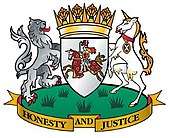Fife Council
Fife Council is the local authority for the Fife area of Scotland and is the third largest Scottish council,[2] with 75 elected council members.
Fife Council | |
|---|---|
| Full council election every 4 years. | |
 | |
 | |
| Type | |
| Type | |
| Leadership | |
Co-Leader of the Council | |
Co-Leader of the Council | |
| Structure | |
| Seats | 75 |
 | |
Political groups |
|
| Elections | |
| Single transferable vote | |
Last election | 5 May 2017 |
Next election | 5 May 2022 |
| Meeting place | |
 | |
| Fife House, Glenrothes | |
| Website | |
| www | |
Councillors are generally elected every five years. At the 2012 election there were 78 councillors elected, but this was reduced to 75 by the time of the 2017 election, after a review by the Boundary commission for Scotland. The number of wards was reduced from 23 to 22.[3]
Councillors make decisions at its regular Council meetings, or those of its nine other general committees (covering for example Tourism and transportation, Education, Environment, Housing, Licensing etc.) and three planning committees.[4]
Following the May 2017 council elections no party was in overall control, resulting in a Power Sharing Agreement being drawn up between the Scottish National Party (SNP) and the Labour group to share control equally. David Alexander (SNP) and David Ross (Labour) were agreed as co-leaders of the council.[1]
A Provost of Fife is elected every five years, who chairs the full council meetings and acts in a ceremonial capacity on behalf of the council.[5] The current Provost is former football manager Jim Leishman MBE, who was first elected in May 2012.[1][6]
Political composition
Immediately following the May 2017 election, the council was composed of the following parties:
| Party | Councillors [7] | |
| SNP | 29 | |
| Labour | 24 | |
| Conservative | 15 | |
| Liberal Democrat | 7 | |
The Conservatives made significant gains and, while the SNP lost its leader on the council, Neale Hanvey, it ended up as the largest party.[8] The SNP and Labour agreed to govern in coalition, with joint council leaders.[7]
Following the May 2012 election, the council was composed as follows:
| Party | Councillors | |
| Labour | 35 | |
| SNP | 26 | |
| Liberal Democrat | 10 | |
| Independent | 4 | |
| Conservative | 3 | |
Labour ran a minority administration.
References
- "Fife Council agree to SNP and Labour joint partnership". Dunfermline Press. 18 May 2017. Retrieved 6 January 2018.
- "Fife News : Fife Welcomes Cllr Lizz Mogg as Fife Deputy Provost". City Local. 20 December 2007. Retrieved 7 January 2017.
- "Local Government Boundary Commission for Scotland's 5th Electoral Review" (PDF). Scottish Government. Retrieved 6 January 2018.
- "Committees". Fife Council. Retrieved 6 January 2018.
- "The Provost and his role". Fife Council. Retrieved 6 January 2018.
- "Jim Leishman elected as Fife's provost". BBC News. 17 May 2012. Retrieved 6 January 2018.
- "Breakthrough as SNP and Labour agree to share Fife Council control", Fife Today, 17 May 2017. Retrieved 6 January 2018.
- "Local Elections: Latest results updated...", Fife Today, 5 May 2017. Retrieved 6 January 2017.